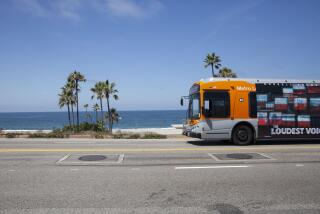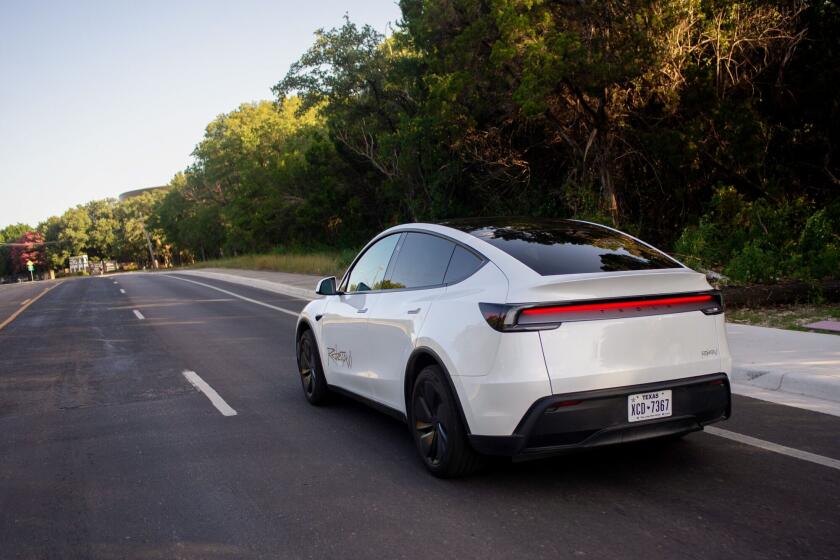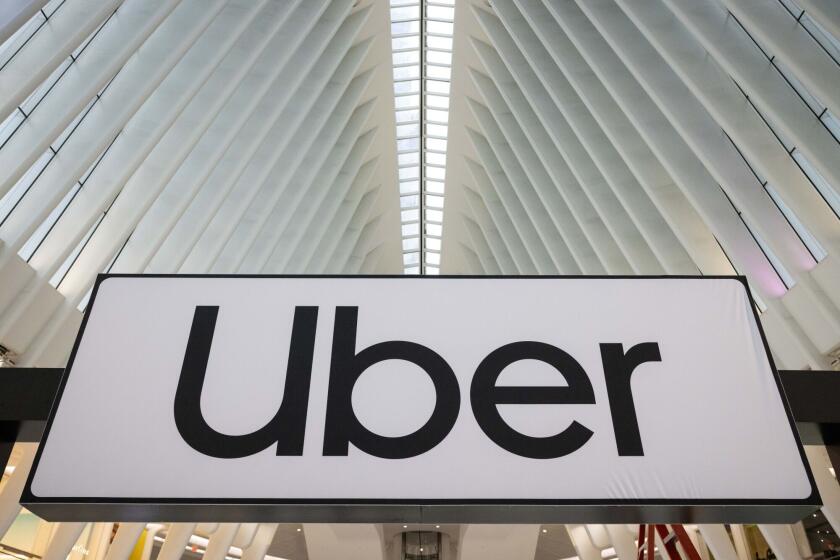Red Lemons : East German Trabant Cars Are Unwanted Relics in L.A.
- Share via
The automobiles they were driving were all but held together by bailing wire and glue. Still, three German tourists were unprepared for what happened when they drove into Los Angeles.
The bottom fell out from under them.
The market for the East German-made Trabant automobiles they had brought to this country--two of the three cars survived the trip--had disappeared faster than the Berlin Wall.
After shipping the smoky, noisy little cars over the Atlantic, then tortuously driving them cross-country to car-crazy Los Angeles, the tourists were stuck with the ultimate lemon.
“They thought they could sell them in Los Angeles and make a lot of money,” said Willi Boelcke, a Los Angeles car restorer who recently found the visitors vainly trying to sell the Trabants at a Pomona swap meet.
Unsafe to drive, uncomfortable to ride in and unpleasant to look at, the Trabant was a symbol of clunky Communist technology until two months ago. That is when the last one rolled off the assembly line in Zwickau, Germany.
Trabants cost about $8,600 new and were coveted for decades by East Germans. The demand evaporated last fall after Germany’s unification.
East German motorists suddenly could buy any car they wanted. Those who could afford it quickly traded in their Trabants for Western-style autos. Some of the 3 million Trabants produced since the 1950s were abandoned on the street.
So there was plenty of excitement this spring when German newspapers and magazines printed stories about Trabants fetching thousands of dollars from American car collectors eager to own a piece of history.
In El Segundo, German-born college student Rainer Meyrer was recruited by a friend back home to become a Los Angeles sales agent for used Trabants. The friend had purchased three of the old cars and was prepared to buy more and ship them to California.
“He sent me an ad from a German magazine saying they were hot cookies in the U.S.,” said Meyrer, 27, an economics major at Cal State Long Beach. “He said they were selling for $10,000 each. He said it would be an easy way to make money.”
At his friend’s instruction, Meyrer placed an ad in the newspaper and waited for his phone to ring. It was a long wait. After a month, he had received two inquiries, and neither caller bought a car.
It is unknown how many Trabants are in California. A spokesman for the state Department of Motor Vehicles said records are not kept on the basis of automobile make. Officials oC. Polk & Co. of Carson, which keeps statistics on cars, said they do not list the Trabant.
DMV officials say any Trabant newer than 1974 must meet tough state air quality standards as well as federal bumper and side-impact safety regulations in order to be registered and driven in the state.
The three cars that the German tourists drove across the United States were not much to write home about. One broke down in Arizona and the tourists stripped it of its motor, transmission, lights and other parts.
By the time they wheeled the two remaining Trabants into the swap meet, the young men were desperate. They pounced on the German-born Boelcke when he paused to look at the cars.
“I’d always dreamed of owning one,” Boelcke said. “When I lived in West Germany, you couldn’t buy them.”
The tourists, all university students from Berlin, said they had read that they could sell old Trabants for $6,000 each in Los Angeles.
But they jumped at the opportunity when Boelcke offered $2,000 for the newer of their cars, a gray 1964 sedan. After huddling together, they decided to give him the other one, a 1959 model. For good measure, they tossed in the spare parts from the Trabant they had stripped and left behind in Arizona.
“I carried off the engine in a plastic bag,” Boelcke said of the two-stroke, 26-horsepower motor.
Boelcke and a friend, mechanic Ron Weaver, drove the Trabants to a storage garage in North Hollywood. These days, Boelcke takes the cars on occasional spins--primarily to watch the surprised looks of other drivers.
“These cars are as much a symbol of Communism as the Berlin Wall,” he said. “They’re a significant memento of the times. They’re symbolic of everything bad in East Germany.”
The older of the two Trabants is particularly eye-catching. Its body, a concoction of resin and cotton matting, is painted orange. It sports a Soviet-made steering wheel with the word “rallye” printed on it and a handmade, wood-cased tachometer.
When a stranger asked to take a picture of one of the Trabants, Boelcke drove it into a grimy alley behind an abandoned building.
“This is a good spot,” he laughed. “It looks like East Germany.”
Boelcke offered to pose for the picture by sitting on the car’s fender. But he had second thoughts when he tapped his knuckles on the plastic body. “Oops, I’d better be careful,” he laughed.
He said he wants to keep one of his cars and sell the other. He plans to send the profit to the three German students.
They can use the money.
“They were starving,” he said.
More to Read
Sign up for Essential California
The most important California stories and recommendations in your inbox every morning.
You may occasionally receive promotional content from the Los Angeles Times.














